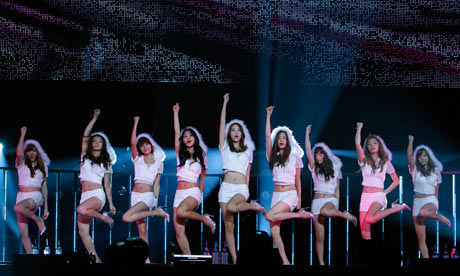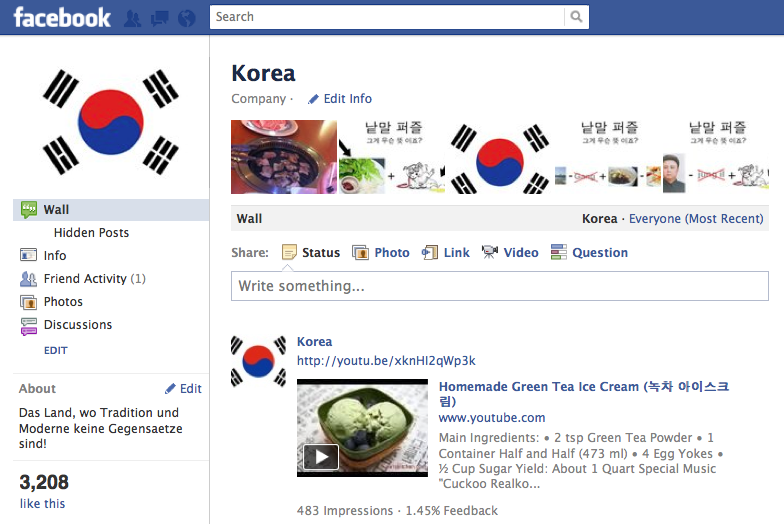Category Archives: Uncategorized
Werde Korea Fan auf Facebook ^-^
Erfahre noch mehr ueber Korea und treffe Gleichgesinnte! Einfach aufs Bild klicken und “liken”
http://www.facebook.com/pages/Korea/351662717507
Meine Lieblings-(Ramen)-Suppe
Korea hat die Pizza erfunden!
Girls’ Generation lead K-pop invasion of Japan
South Korean bands sweep ‘cute’ J-pop idols from charts to conquer world’s second largest music market

Girls’ Generation are leading the K-pop charge into Japan, playing in front of 20,000 fans in Tokyo last summer. Photograph: Shizuo Kambayashi
The language is unmistakably Japanese, the lyrics delivered in familiar high-pitched tones over a backdrop of electronica. But the wave of pop music sweeping Japan is not the sugar-coated homegrown variety that has long clogged the airwaves.
Japanese teens and twentysomethings who once had ears only for J-pop are now transfixed by K-pop, a phenomenon from South Korea that is taking the world’s second-biggest music market by storm.
Korean pop culture’s first foray into Japan was led almost a decade ago by Bae Yong-joon, an actor whose mainly middle-aged, female devotees nicknamed him Yon-sama, or the Honourable Yon.
South Korea’s prodigious output of trendy dramas featuring actors with impossibly perfect – possibly surgically enhanced – features and improbable plots has been followed by music whose popularity defies the often testy diplomatic relations between Tokyo and Seoul.
The genre has produced a steady stream of award-winning hits and fuelled an assault on the Japanese pop charts that few western artists have matched.
Its roots lie in the Tokyo debut a few years ago of Toho Shinki, a boyband who recently released their fifth album for the Japanese market. They were followed by a string of girlbands, led by Girls’ Generation, a nine-member group who performed in front of more than 20,000 fans in Tokyo last summer and completed a sellout tour of Japan earlier this year.
Kara, an all-female quintet, made their Japanese debut last year and won best new artist at the Japan Gold Disc Awards. K-pop idolatry is played out daily on the streets of Shin-Okubo, a Tokyo neighbourhood packed with Korean restaurants and shops selling K-pop paraphernalia.
For Kaori Kitakata, a devotee since she was introduced to the genre by Korean friends, K-pop is a change from the overtly cute mien cultivated by popular Japanese girlbands such as Morning Musume.
“The Korean girlbands look more professional,” she says. “Japanese singers are more like the girl next door in the way they sing and dance, but Korean singers are better trained and more sophisticated.”
Korean artists, the 28-year-old adds, appear less diffident than J-pop groups about their Asian identity. “J-pop female bands are cute, but in a very Japanese kawaii [cute] way,” she says. “K-pop singers have a more Asian feel to them. That appeals to me. And their fans here appreciate their attempts to learn Japanese.”
The linguistic nod makes commercial sense. Japan is the second biggest music market in the world after the US, with a 22% global share, according to the International Federation of the Phonographic Industry. CD sales in South Korea, where broadband penetration encourages filesharing, are one 30th of those in Japan.
K-pop artists have taken localisation to its natural conclusion: in their native South Korea, Toho Shinki are known as Dong Bang Shin Ki, while the rest of the world knows them as TVXQ. Girls’ Generation perform in Japan as Shojo Jidai, and in South Korea as So Nyuh Shi Dae.
Stephen McClure, the Tokyo-based editor of McClure’s Asia Music News, attributes some of K-pop’s popularity to stylistic differences with its “less sophisticated” J-pop counterpart.
Even a novice, he says, should immediately notice the musical divide separating, say, 1!2!3!4! Yoroshiku by Japan’s girlband of the moment AKB48, and Mr Taxi by Girls’ Generation.
“The former is mindless and full-on, with no sense of dynamics,” says McClure. “They just never stop singing. The latter, though, is a beautifully constructed pop song.”
South Korean management companies invest considerable time and money in tailoring their acts to the Japanese market, McClure adds. “The bands have made an incredible effort to learn the rules of the game, they do all the right commercial endorsements and appear on the popular music shows. They have come up with a very marketable product that fits the Japanese template for idol pop.”
The K-pop wave has spread to Thailand and Malaysia, and there are stirrings of interest in the US, Latin America and Europe. “If anyone from Asia is going to make it internationally, it will be a Korean artist,” says McClure.
Source: http://www.guardian.co.uk/world/2011/sep/30/japanese-pop-girls-generation
Best of cabage, green cabage, sauerkraut and kimchi
GD&TOP – High High
Hmmm, catchy aber auch ein bischen gay!
K-pop Flashmob Hamburg
K-Pop world domination!
Koreaner sind ohne Höhenangst
Forscher erschaffen Hund mit Lichtschalter
Südkoreanische Forscher haben einen Hund geklont, der nachts leuchten kann. Über Futterzugaben lässt sich die Leuchtfähigkeit ein- bzw. ausschalten.

Im Jahr 2005 klonten südkoreanische Forscher erstmals einen Hund, den sie “Snuppy” nannten: Hwang Woo Suk (l.) wurde später als Fälscher entlarvt. “Snuppy” stellte sich dennoch als “echter” Klonhund heraus
Dank eines fluoreszierenden Gens leuchtet der Hund im Dunkeln, sobald man dem Tierfutter das Antibiotikum Doxycyclin hinzufügt, berichtete die nationale Nachrichtenagentur Yonhap am Mittwoch. Dadurch könne man die Leuchtfähigkeit des Hundes „an- und ausschalten“.
Durch das Klonen genmanipulierter Tier erhoffen sich die Forscher Fortschritte bei der Behandlung von Gendefekten bei Menschen. Der neue Klonhund eröffne „neue Horizonte, da das injizierte Gen, das den Hund zum Leuchten bringt, durch Gene ersetzt werden kann, die tödliche menschliche Krankheiten auslösen können“, wurde Lee zitiert. Bei 268 Krankheiten von Hunden könne man gleiche Merkmale mit genetischen Krankheiten bei Menschen feststellen.
Bereits 2009 leuchtete erstmals ein Klonhund
Das Beagle-Weibchen „Tegon“ war nach Angaben Lees 2009 zur Welt gekommen. Zwei Jahre habe man Tests an dem Tier durchgeführt. Dank des fluoreszierenden Gens leuchte „Tegon“ bei Bestrahlung mit ultraviolettem Licht grün. Die Ergebnisse des Experiment wurden laut Yonhap in der jüngsten Ausgabe des Fachjournals „Genesis“ veröffentlicht.
Bereits im April 2009 hatte Lee die ersten Hunde mit künstlich eingesetztem Gen der Welt vorgestellt. Damals handelte es sich um vier geklonte Beagles, die ebenfalls dank fluoreszierender Gene im Dunkeln flimmern.
Lee war Mitglied des Teams um den später als Fälscher entlarvten Klonexperten Hwang Woo Suk, der im August 2005 den ersten Klonhund, „Snuppy“, vorgestellt hatte. Während zwei Studien Hwangs zu embryonalen Stammzellen als Fälschung aufgedeckt wurden, hatte sich „Snuppy“ tatsächlich als Klon erwiesen.



